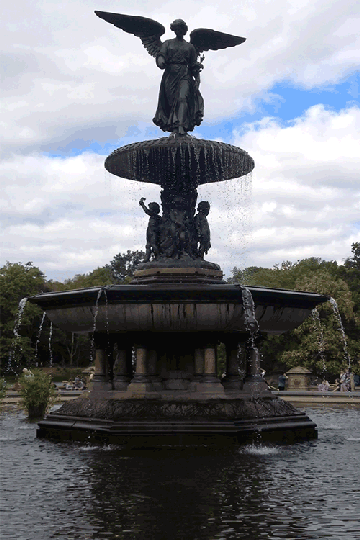Central Park
Bethesda Angel Fountain
Bethesda Angel Fountain

Bethesda Terrace and Fountain overlook The Lake in New York City's Central Park. The fountain, with its Angel of the Waters statue, is located in the center of the terrace.
Bethesda Terrace is on two levels, united by two grand staircases
and a lesser one that passes under Terrace Drive. They provide passage
southward to the Elkan Naumburg bandshell and The Mall
at the center of the park. The upper terrace flanks the 72nd Street
Cross Drive and the lower terrace provides a podium for viewing the
Lake. The mustard-olive colored carved stone is New Brunswick sandstone, with a harder stone for cappings, with granite steps and landings, and herringbone pattern paving of Roman brick laid on edge.
Bethesda Fountain is the central feature on the lower level of the terrace, constructed between 1859 and 1864, which is enclosed within two elliptical balustrades.
The pool is centered by a fountain sculpture designed by Emma Stebbins in 1868 and unveiled in 1873. Stebbins was the first woman to receive a public commission for a major work of art in New York City.
The bronze, eight-foot statue depicts a female winged angel touching
down upon the top of the fountain, where water spouts and cascades into
an upper basin and into the surrounding pool. It was the only statue in
the park called for in the original design. Beneath her are four
four-foot cherubs representing Temperance, Purity, Health, and Peace.
Also called the Angel of the Waters, the statue refers to Healing the paralytic at Bethesda, a story from the Gospel of John about an angel blessing the Pool of Bethesda, giving it healing powers. In Central Park the referent is the Croton Aqueduct opened in 1842, providing the city for the first time with a dependable supply of pure water: thus the angel carries a lily in one hand, representing purity, and with the other hand she blesses the water below.

The base of the fountain was designed by the architect of all the original built features of Central Park, Calvert Vaux, with sculptural details, as usual, by Jacob Wrey Mould. In Calvert Vaux and Frederick Law Olmsted's 1858 Greensward Plan, the terrace at the end of the Mall overlooking the naturalistic landscape of the Lake was simply called The Water Terrace, but after the unveiling of the angel, its name was changed to Bethesda Terrace.

The panels of carving in the abstracted organic style propounded by Owen Jones, a mentor of the sculptor Jacob Wrey Mould are organized by an iconographical program of themes: the Seasons, the Times of Day, the Ages of Mankind. Considerable latitude was offered the carvers executing the work, following Ruskinian principles.

No comments:
Post a Comment